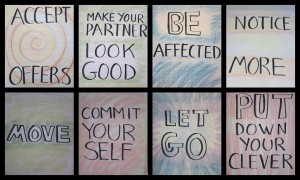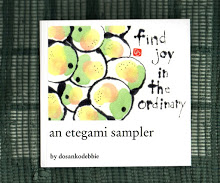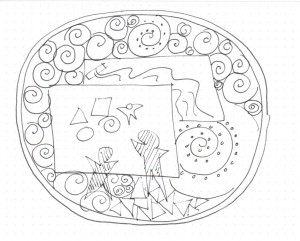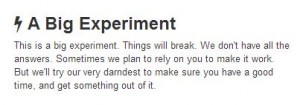
This past weekend I was up in Vancouver, BC, for two gatherings that I always enjoy, the BC Campus’ Online Community Enthusiasts group (led by the always wonderful Sylvia Currie) and the Canadian blogging/social media conference, Northern Voice. OCE is a place to hang with people who wisely use online interaction, mostly in the learning context.
This year I was once again on the OCE hosting team and my job was to give an overview of the agenda, then facilitate the afternoon’s Open Space. I made a visual agenda, but in a circle it is rather hard to see, so I spontaneously became a human lazy susan. Alan Levine caught me in the act with a still, and later with an animated gif.
We had a great time with Dave Pollard leading us in some exercises using the terrific Groupworks group process pattern cards. They really elicited some insightful stories from the group and I was so inspired, I called an Open Space session in the afternoon to think about how I could use them in a webinar I ran on Monday. Bingo! As always, hanging out with friends new and old was the highlight.
 Northern Voice is where I always submit weird session proposals and those crazy Canadians usually say yes to me. Silly them. My supporting role for 2012 was to co-facilitate Moosecamp, the OpenSpace of NorthernVoice, with Brian Lamb. Brian asked me to make a little announcement at the start of the conference about Moosecamp. I had decided on a whim to bring my new uke, and at the last minute decided to improvise a song about Moosecamp instead of saying it. I blogged about that already. 😉
Northern Voice is where I always submit weird session proposals and those crazy Canadians usually say yes to me. Silly them. My supporting role for 2012 was to co-facilitate Moosecamp, the OpenSpace of NorthernVoice, with Brian Lamb. Brian asked me to make a little announcement at the start of the conference about Moosecamp. I had decided on a whim to bring my new uke, and at the last minute decided to improvise a song about Moosecamp instead of saying it. I blogged about that already. 😉
This year my formal submission was a session with Rob Cottingham, Alan Levine and I on improvisation. I have been very inspired by Viv McWaters and Johnnie Moore’s work to bring improv into facilitation. Our session started with each of us telling a two minute story of where improvisation played an important role, while the other two mimed the story. Then we introduced the group to Viv and Johnnie’s improv cards, which I turned into flip chart images.
We invited people to go to the flip chart they felt MOST uncomfortable with. They then discussed the why’s and wherefore’s of their discomfort. THEN we invited each group to create a human sculpture that expressed that card. We had eight great, laughter inducing performances.

Alan then showed us his PechaFlickr applications which draws five cards with a shared tag from Flickr and you get to tell a story to go with them. Alan had five volunteers who each added an element to a story illustrated by tug boats! Give it a try yourself here. It could be a great icebreaker!
Then we segued into a classic gibberish improv and our three volunteers blew me away. They dove right in. I was laughing so hard I was crying.
For us, it was important that this was not just about the performance side of improv, but about how improv can inform our practices every day, help us be more present in every moment. Rob Cottingham gave a insightful, improvised wrap up that inspired us all. We have 1140 minutes every day. We might as well use them well.
I loved Boris Mann’s recap:
Next I went to Improv Me, Baby with Nancy White, Alan Levine, and Rob Cottingham. My basic rule of thumb is “go to any session that Nancy White is involved with”. Of course Alan and Rob are no slouches either 😉 Lots of interactivity and group activity in getting people to participate, and to understand what improv actually means. Rob closed things out talking about how the very best improv can in fact be the result of lots of preparation and practice ahead of time, while still using a “go with the flow” approach to tailor presentations & experiences to the people and energy in the room.
In the Moosecamp/Open Space giulia.forsythe ran a great hands on session about how to do sketchnoting on the iPad and I now finally understand layers. (I’m slow.) She later did a sketchnote of the improv session which I TREASURE! What a great memento/take away!
via Northern Voice Retrospective [visual Notes] | Flickr – Photo Sharing!.
All in all it was a great weekend – learning, play, improv, music, friends and food! Perfeito!








